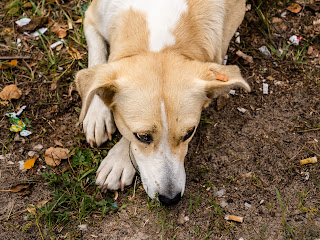In 1986, the Chernobyl Nuclear Power Plant (CNPP) now in modern-day Ukraine faced the world’s most critical nuclear disaster. It caused massive ecological destruction in the Chernobyl Exclusion Zone (CEZ), which spans over 2600 sq km, reducing the area’s wildlife populations significantly.
Thirty years since the tragedy, no detailed study had been conducted on large-bodied mammals that survived in this area. Finally, the first-ever genetic study probed into the genetic composition of free-breeding dogs living within and around the Chernobyl nuclear disaster site.
One would think that a disaster-struck wasteland would be a difficult place to call ‘home’, but the wildlife living here proves otherwise. The free-roaming dog population in the region presents an interesting case of surviving a nuclear holocaust. The origin of these dogs and how they survived after the explosion are not well known. Researchers believe that the current population of dogs descended from the pets left behind by the people who were evacuated from the area.
Following the evacuation of residents from the CEZ, the Ukrainian Government began culling abandoned pets in order to prevent the spread of radioactive pollution. Dogs that evaded hunters were subsequently fed and cared for by Chernobyl cleanup workers and tourists. As a result, over the decades following the accident, the populations of semi-feral dogs eventually increased in the region.
Drawing parallels between Chernobyl dogs and the global canine population
When the team of scientists conducted a genetic analysis of the DNA of about 302 dogs inhabiting the power plant area and nearby regions, they came across a shocking revelation. At first, it was assumed that all the dogs might be much alike each other due to excessive inbreeding.
But the genetic analysis of these dogs living in areas with different levels of radiation exposure revealed the existence of two locally distinct canine populations. The population living in and around the power plant is separate from the other one inhabited at places which are 15 to 45 km away.
What’s more surprising is that these Chernobyl puppies are genetically different from the canine population in the rest of the world. On comparing their genomes, researchers were able to identify the genetic changes that happened purely due to radiation exposure apart from those occurring naturally.
Image credits: Wikimedia Commons
The stray dogs, who are still very much good boys, have the tendency to form packs of related individuals, much like their wild canid ancestors. The findings also reveal that within this region, small family groups or packs of free-roaming dogs coexist in close proximity to each other, a phenomenon that contradicts the belief that such dogs are solitary animals.
How Man’s best friend once again generously helps man
The dogs’ tolerance to tough living circumstances makes them a good source for identifying mutational fingerprints caused by previous and continuing radiation exposures.
Image Credits: Unsplash
This study was the first step of a very long process of identifying how the genome copes with such extreme stress at such a high speed. More research in this direction could help scientists develop therapies, technological gears or some kind of biological shield that can resist radiation and other stressors and protect power plant workers and even astronauts on outer space missions in the future.
The study on the Chernobyl dog population can help us draw important information on how humans suffer while working in a similar environment. The findings opens up new avenues for research on the impact of harsh environmental conditions on wildlife and humans alike. These animals teach us something very important about what ‘living on the edge’ truly means.
Details of this study were published in the recent issue of Science Advances.
If you enjoyed reading our articles, please consider supporting us by buying our geeky merchandise on Instagram.
Alternatively, you could Buy us a coffee or follow us on Facebook, Twitter, Pinterest or Medium!






